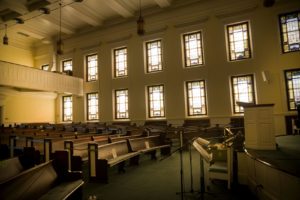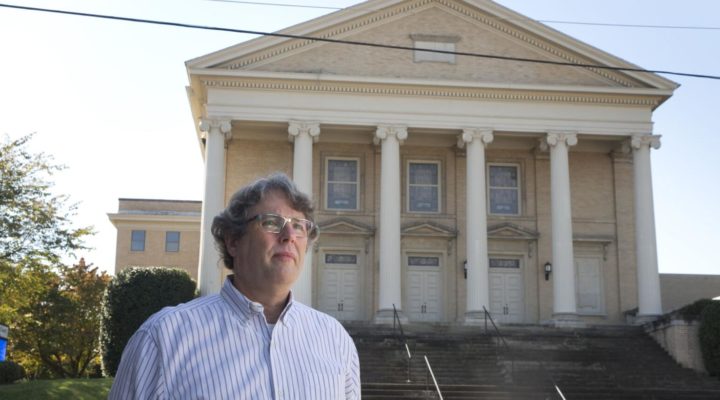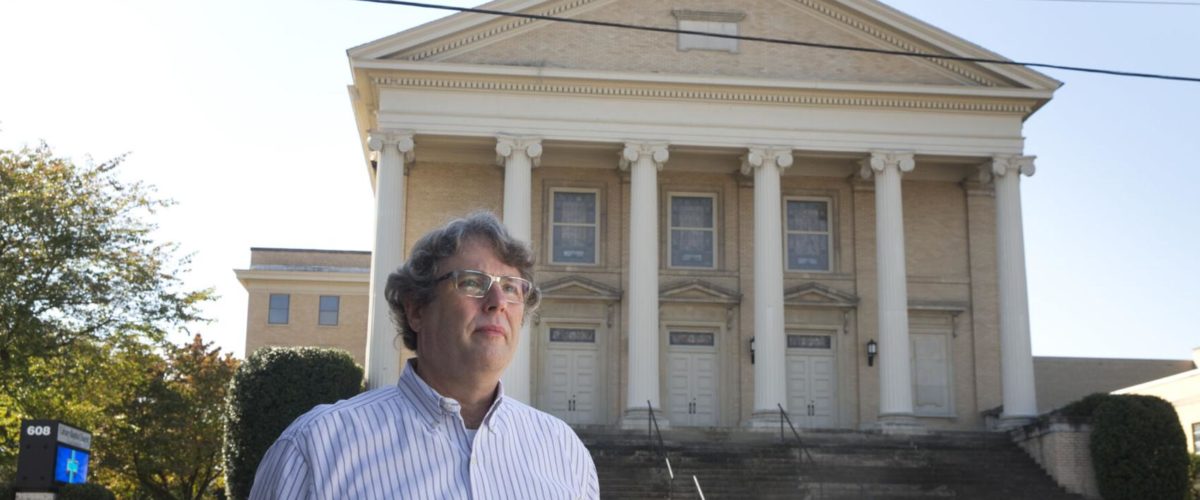It’s a story all-too familiar these days: Historic church building for sale.
This time, it’s Calvary Baptist Church in Roanoke, Va., which has listed its 55,000-square-foot building, which sits on 1.68 acres in downtown Roanoke, at $1.95 million. The historic sanctuary was built in 1925 for $312,000. The congregation itself dates to 1891.

The sanctuary of Calvary Baptist Church in Roanoke, Va. (Heather Rousseau/The Roanoke Times)
Pastor Steven Pollard told the Roanoke Times the sale became necessary because of declining membership and the high cost of maintaining the building. The COVID-19 pandemic became the final stressor and forced the sale.
Before COVID, about 60 people regularly attended services, Pollard told the newspaper. Now that in-person services have resumed, worship draws about half that number.
Selling a church building produces feelings of grief, Pollard said. “Folks were married here, their family funerals were here, baptisms were here, some of the high points of folks’ lives are here.” The church was known locally for three decades for its annual Singing Christmas Tree, and its Aeolian-Skinner pipe organ remains one of the finest instruments in the city.
Yet the cost of maintaining a four-story building built nearly 100 years ago became so prohibitive that when the question was put to a congregational vote, the motion to sell passed without a single nay vote.
Although the congregation will move to a new location by the end of this year — perhaps a shared space with another congregation — the church is not closing, the pastor emphasized. “We want to stay together, and we want to move forward.
“A building to me is not nearly as important — and it shouldn’t be — as our mission and what we’re about as a congregation and staying together.”
“A building to me is not nearly as important — and it shouldn’t be — as our mission and what we’re about as a congregation and staying together,” he told the newspaper.
Calvary Baptist’s story is the story of many churches across America, according to Bill Wilson and Laura Stephens-Reed, church coaches and consultants.
Sinking money into facilities that are poorly maintained or are too large for the congregation creates a trap for some churches, Stephens-Reed said. Calvary Baptist is modeling a more realistic approach, she believes, by considering “ways the property could be creatively shared with the community or that the congregation could become more nimble and responsive to the surrounding neighborhood by moving to a right-sized location.”

A display of pastors who have served the historic Roanoke church. (Heather Rousseau/The Roanoke Times)
Some churches with excess space are finding creative uses and income streams by leasing out space to other congregations or nonprofits. Others, like Calvary, find the upkeep too great to do anything but sell.
“There is a big undercurrent of fear that manifests in a reluctance to re-examine priorities and make changes, leading to paralysis and eventually to making choices by not making them,” she explained.
This aversion to act often is accompanied by “wishful thinking with a tinge of generational and/or pastoral blame,” Stephens-Reed said. “For example, ‘If only we could get a few young families in here’ often implies that younger adults aren’t ordering their lives around the proper values or that the minister isn’t fulfilling the role.”
Failing to make hard decisions over time will wear a congregation out, added Wilson, founder and director of the Center for Healthy Churches.
“There is a fatigue that kind of takes over, a weariness. How do we do more with less? How do we make bricks with straw? We constantly find ourselves shrinking.”

The sanctuary of Calvary Baptist Church in Roanoke, Va. (Heather Rousseau/The Roanoke Times)
With more than 90% of American churches reporting membership that is either plateaued or declining, there is a lot of stress to go around, Wilson said. “It creates … a kind of weariness and sadness and a frustration from not really knowing how to stop that slow leak in the life raft. We are constantly pumping it up, and it’s less and less buoyant.”
And as Calvary found out, that experience is only getting worse with the pandemic, Wilson said. “The tsunami is coming.”
The financial challenges aren’t just on the expense side, either. Stress ramps up when congregational leaders see that a significant percentage of the church’s income derives from people of retirement age or older.
“You can just watch people’s faces fall because they know what that means: our financial model is not sustainable because most of the young adults and middle-aged adults have been lured away by megachurches or they are just not coming to church anymore,” Wilson said.
He sees a pruning of the American church happening, noting that “pruning is both painful and life-giving.”
“The biblical understanding of church is focused on community, and churches that are going to thrive must transform from being self-absorbed to being focused on neighborhoods around them,” Wilson asserted. “Our timeless stuff is more appealing right now than it’s ever been. People are lonely, fractured, and they have found money and politics and materialism wanting. Their health is threatened, and we have a timeless gospel that provides something none of those things can provide.”
Related articles:
Hospitality on the corner: Gaston Christian Center
Sale of Baptist church benefits local charities
Property sale positions Atlanta church to engage its vibrant neighborhood


